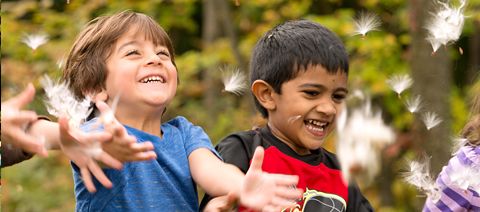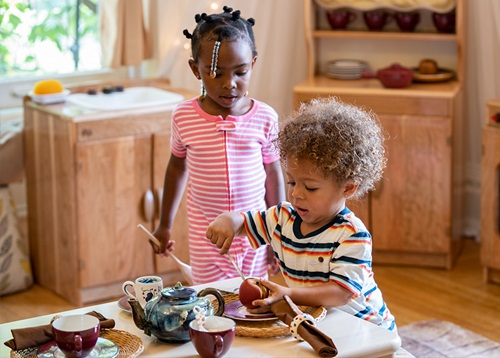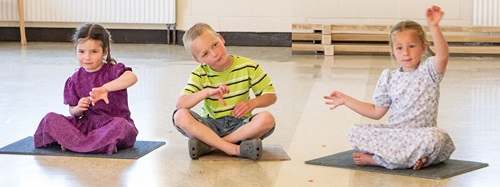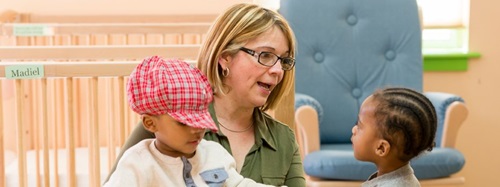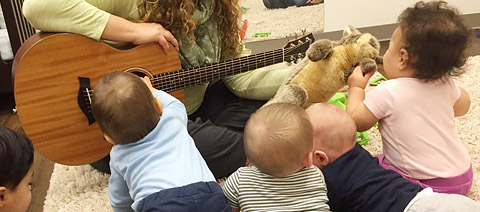Why Movement Matters
| May 2014In my 34 years as an education consultant specializing in children’s physical activity, I’ve come to accept that the majority of people will never see movement as a top priority in children’s lives and education. But if we’re to educate and care for the whole child, movement must be part of the package!
Physical Development
Perhaps the simplest and most important reason children should be allowed and encouraged to move is to develop motor skills. Although it’s commonly believed children automatically acquire motor skills as their bodies develop, maturation only means that children will be able to execute most movement skills at a low performance level. Continuous practice and instruction are needed if the performance level and movement repertoire are to increase. In other words, once a child is able to creep and walk, gross motor skills should be taught—just as other abilities are taught. Furthermore, special attention should be paid to children demonstrating gross-motor delays, as such delays will not simply disappear over time.
Why does the development of motor skills matter, when not every child will go on to become an athlete or a dancer? It matters because children who feel confident in their movement skills are likely to continue moving throughout their lives. And that’s significant because of the many health problems caused by sedentary living.
Although children love to move—and adults tend to think of them as constantly being in motion—children today are leading much more sedentary lives than did their predecessors. According to research, children ages 2 to 5 spend close to 25 hours of TV time each week. In fact, watching television is the predominant sedentary behavior in children, second only to sleeping. The advent of computers and video games has also contributed to the decline in activity. A study from the Kaiser Family Foundation determined that children ages 8 to 18 are spending more than seven and a half hours a day with electronic devices—the same number of hours some people spend at full-time jobs!
According to research, there is one consistent observation that stands out among the studies of energy expenditures in young children: those under the age of 7 seem to expend about 20 to 30 percent less energy in physical activity than the level recommended by the World Health Organization. The Children’s Activity and Movement in Preschools Study (CHAMPS) determined that children enrolled in preschools took part in moderate to vigorous physical activity (MVPA) during only 3.4 percent of the preschool day.
Considered together, these factors provide cause for concern regarding children’s fitness levels. Statistics indicate that 40 percent of five to eight-year-olds show at least one heart disease risk factor, including hypertension and obesity. The latter, which is on the rise, particularly among children, has been linked to television viewing. A Canadian study determined that the blood vessels of obese children have a stiffness normally seen in much older adults who have cardiovascular disease. Furthermore, the Centers for Disease Control and Prevention (CDC) estimates that American children born in the year 2000 face a one-in-three chance of developing type 2 diabetes, previously known as adult-onset diabetes because it was rarely seen in children.
Developmentally appropriate movement experiences can give children the practice and instruction necessary to refine their movement skills and expand their movement vocabularies. Moreover, if the children have frequent opportunity to experience success in physical activity, it will make movement pleasurable for them. Thus they are more likely to become (and stay!) physically fit.
Social/Emotional Development
Marianne Frostig, in her classic book Movement Education: Theory and Practice, says, "Movement education can help a child to adjust socially and emotionally because it can provide him with successful experiences and permit interrelationships with other children in groups and with a partner. Movement education requires that a child be aware of others in [activities] in which he shares space…; he has to take turns and to cooperate. He thus develops social awareness and achieves satisfaction through peer relationships and group play."
During movement experiences, even before children are asked to work cooperatively with partners and groups, they must be aware of others around them, adjusting their movement patterns to avoid collisions. Of course, any time children work in pairs or in groups, they are learning lessons in cooperation and consideration.
By employing a creative problem-solving approach (for example, “Show me how slowly a turtle moves,”) as often as possible, you will ensure that the children experience frequent success, as they respond to challenges at their own developmental levels and rates. This approach increases children’s self-confidence, and thus their self-esteem, as they see their choices being accepted and validated. Two additional—and important—results of problem solving are the development of patience with peers and an enhanced respect for other people’s ideas.
The development of empathy is also promoted through exposure to certain social issues that will, hopefully, make positive impressions in children’s young and open minds. For example, to physically imitate the movements and characteristics of a variety of animals is to imagine what it is like to be those animals.
Cognitive Development
It has been said that joy is the most powerful of all mental stimuli. For young children, movement is certainly joyous. Beyond that, however, studies of how young children learn have proven that they especially acquire knowledge experientially—through play, experimentation, exploration, and discovery.
For example, when children move over, under, around, through, beside, and near objects and others, they better grasp the meaning of these prepositions and geometry concepts. When they perform a “slow walk” or skip “lightly,” adjectives and adverbs become much more than abstract ideas. When they’re given the opportunity to physically demonstrate such action words as stomp, pounce, stalk, or slither—or descriptive words such as smooth, strong, gentle, or enormous—word comprehension is immediate and long lasting. The words are used and learned in context, as opposed to being a mere collection of letters. This is what promotes emergent literacy and a love of language.
Similarly, if children take on high, low, wide, and narrow body shapes, they’ll have a much greater understanding of these quantitative concepts—and opposites—than do children who are merely presented with the words and their definitions. When they act out the lyrics to “Ten in the Bed” (“There were five in the bed, and the little one said, ‘Roll over’…”), they can see that five minus one leaves four. The same understanding—and fascination—results when children have personal experience with such scientific concepts as gravity, flotation, evaporation, magnetics, balance and stability, and action and reaction.
Additionally, according to Dr. Carla Hannaford, author of Smart Moves: Why Learning Is Not All in Your Head, learning by doing creates more neural networks in the brain and throughout the body, making the entire body a tool for learning. There is a growing body of research determining that physical activity activates the brain much more so than doing seatwork. While sitting increases fatigue and reduces concentration, moderate to vigorous intensity movement feeds oxygen, water, and glucose (brain food!) to the brain, optimizing its performance.
Making Movement Part of the Program
Following are some tips to ensure successful, satisfactory movement experiences for both you and the children:
- If you’ve set aside a certain amount of time during the day for movement (and I hope you will), be sure to plan more activities than you think you might need. Due to the nature of children, it is possible that one session will last thirty minutes, the next only twenty minutes, and the following just fifteen!
- Repeat activities often! Children need numerous opportunities to get it right, or simply to experience repeated success.
- Introduce your movement challenges with statements like “Show me you can” or “Let me see you.” The children will want to show you they can! It is a simple technique, but amazingly effective.
- Incorporate such rules as “We will give each other enough space to move” and “We will move as quietly as possible.” Movement activities should take place in a friendly, encouraging, and fun atmosphere, balanced with some basic ground rules for human behavior. This atmosphere, together with the fact that the children are experiencing success, will ensure that behavioral problems will be minimal.
- Whenever possible, the children should move in unrestrictive clothing. The most important contribution to effective movement is probably the bare foot. Children have worn sneakers during physical activity for so long now that we seem to have forgotten that the feet do have sentient qualities. They can grip the floor for strength and balance, and the foot consists of different parts (toes, ball, heel) that can be more easily felt and used when bare. Besides, young children feel a natural affinity for the ground, which can be enhanced by stripping away all the barriers between it and the feet!
- End movement experiences with a relaxation exercise! Relaxation is a learned (and much needed) skill and prepares children for slow or sustained movement, which requires greater control than fast movement. Being relaxed also provides children with the opportunity to experience motionlessness, giving more meaning, in contrast, to movement. Tension control can also help children learn better, as stress has a negative impact on learning.
You and the children should now be ready to begin moving and learning!
This article is an adapted excerpt from the three books in my Moving & Learning Series: Toddlers Moving & Learning, Preschoolers & Kindergartners Moving & Learning, and Early Elementary Children Moving & Learning (St. Paul MN: Redleaf Press, 2014).

